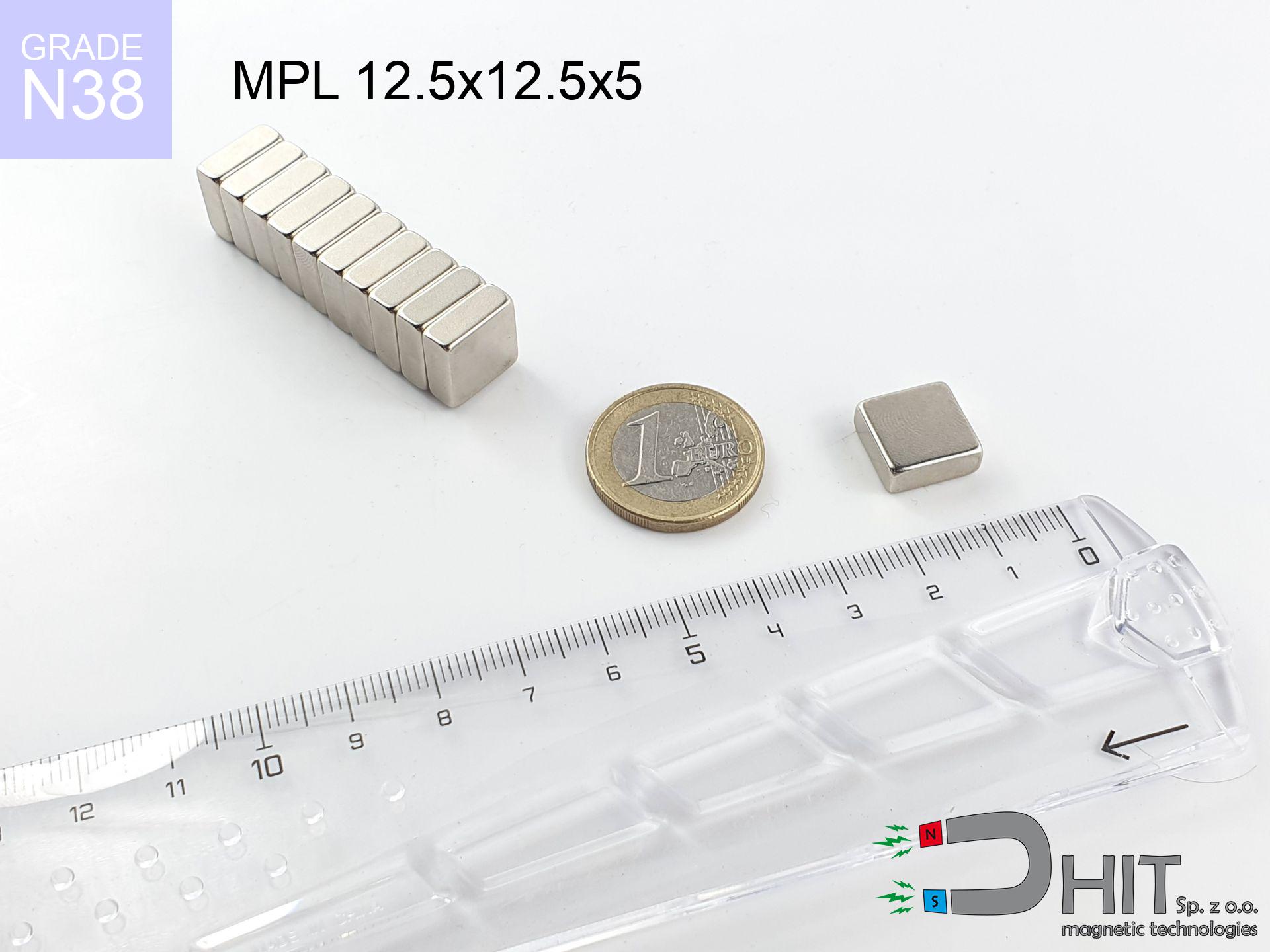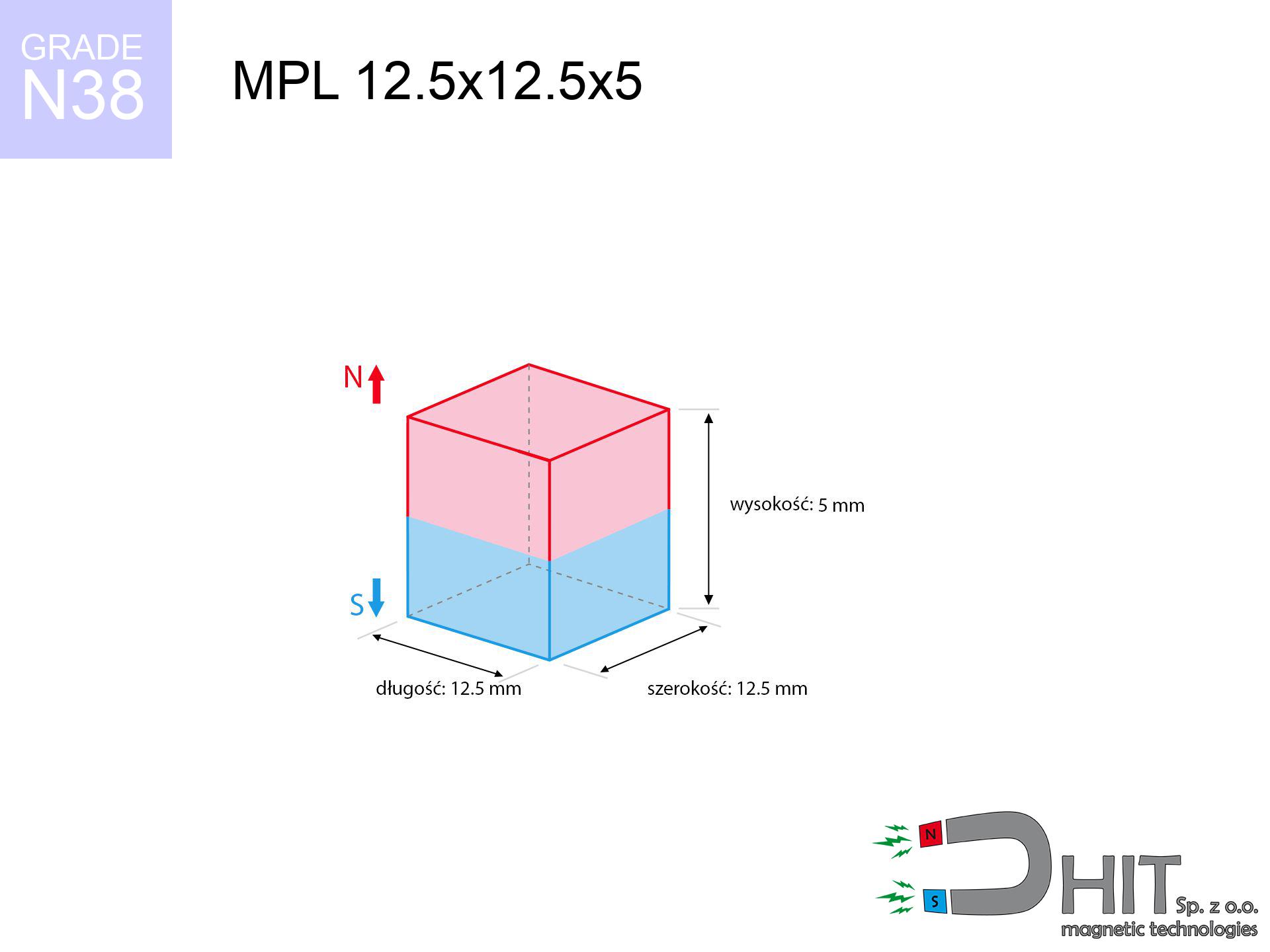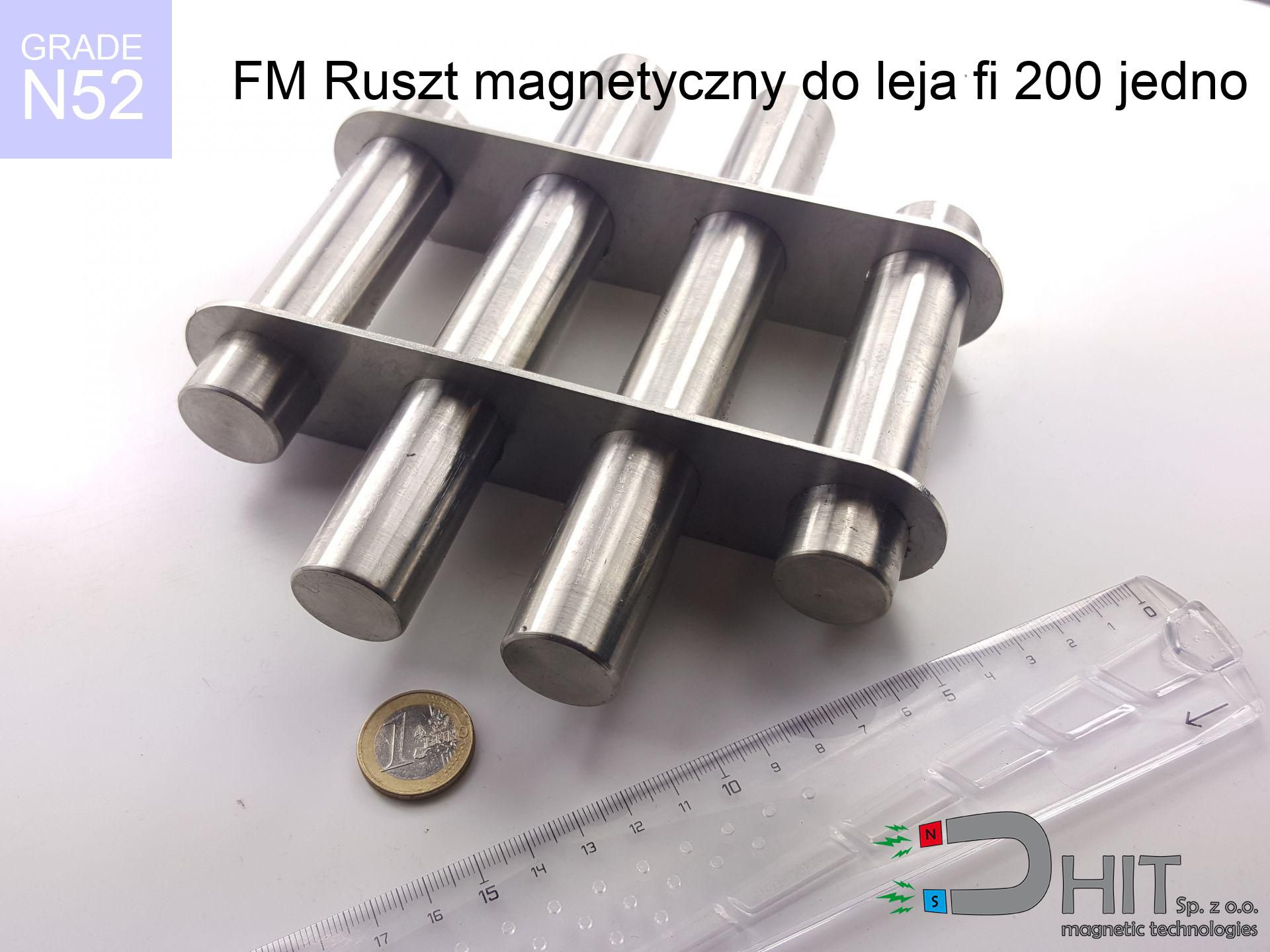MPL 12.5x12.5x5 / N38 - lamellar magnet
lamellar magnet
Catalog no 020117
GTIN/EAN: 5906301811237
length
12.5 mm [±0,1 mm]
Width
12.5 mm [±0,1 mm]
Height
5 mm [±0,1 mm]
Weight
5.86 g
Magnetization Direction
↑ axial
Load capacity
4.84 kg / 47.51 N
Magnetic Induction
360.91 mT / 3609 Gs
Coating
[NiCuNi] Nickel
2.83 ZŁ with VAT / pcs + price for transport
2.30 ZŁ net + 23% VAT / pcs
bulk discounts:
Need more?Not sure about your choice?
Call us
+48 22 499 98 98
otherwise send us a note by means of
request form
the contact page.
Strength and form of magnets can be calculated using our
online calculation tool.
Orders placed before 14:00 will be shipped the same business day.
MPL 12.5x12.5x5 / N38 - lamellar magnet
Specification / characteristics MPL 12.5x12.5x5 / N38 - lamellar magnet
| properties | values |
|---|---|
| Cat. no. | 020117 |
| GTIN/EAN | 5906301811237 |
| Production/Distribution | Dhit sp. z o.o. |
| Country of origin | Poland / China / Germany |
| Customs code | 85059029 |
| length | 12.5 mm [±0,1 mm] |
| Width | 12.5 mm [±0,1 mm] |
| Height | 5 mm [±0,1 mm] |
| Weight | 5.86 g |
| Magnetization Direction | ↑ axial |
| Load capacity ~ ? | 4.84 kg / 47.51 N |
| Magnetic Induction ~ ? | 360.91 mT / 3609 Gs |
| Coating | [NiCuNi] Nickel |
| Manufacturing Tolerance | ±0.1 mm |
Magnetic properties of material N38
| properties | values | units |
|---|---|---|
| remenance Br [min. - max.] ? | 12.2-12.6 | kGs |
| remenance Br [min. - max.] ? | 1220-1260 | mT |
| coercivity bHc ? | 10.8-11.5 | kOe |
| coercivity bHc ? | 860-915 | kA/m |
| actual internal force iHc | ≥ 12 | kOe |
| actual internal force iHc | ≥ 955 | kA/m |
| energy density [min. - max.] ? | 36-38 | BH max MGOe |
| energy density [min. - max.] ? | 287-303 | BH max KJ/m |
| max. temperature ? | ≤ 80 | °C |
Physical properties of sintered neodymium magnets Nd2Fe14B at 20°C
| properties | values | units |
|---|---|---|
| Vickers hardness | ≥550 | Hv |
| Density | ≥7.4 | g/cm3 |
| Curie Temperature TC | 312 - 380 | °C |
| Curie Temperature TF | 593 - 716 | °F |
| Specific resistance | 150 | μΩ⋅cm |
| Bending strength | 250 | MPa |
| Compressive strength | 1000~1100 | MPa |
| Thermal expansion parallel (∥) to orientation (M) | (3-4) x 10-6 | °C-1 |
| Thermal expansion perpendicular (⊥) to orientation (M) | -(1-3) x 10-6 | °C-1 |
| Young's modulus | 1.7 x 104 | kg/mm² |
Physical analysis of the product - technical parameters
Presented information constitute the result of a physical calculation. Values rely on algorithms for the class Nd2Fe14B. Actual conditions might slightly deviate from the simulation results. Treat these data as a preliminary roadmap during assembly planning.
MPL 12.5x12.5x5 / N38
| Distance (mm) | Induction (Gauss) / mT | Pull Force (kg) | Risk Status |
|---|---|---|---|
| 0 mm |
3608 Gs
360.8 mT
|
4.84 kg / 4840.0 g
47.5 N
|
strong |
| 1 mm |
3156 Gs
315.6 mT
|
3.70 kg / 3704.2 g
36.3 N
|
strong |
| 2 mm |
2671 Gs
267.1 mT
|
2.65 kg / 2653.8 g
26.0 N
|
strong |
| 3 mm |
2211 Gs
221.1 mT
|
1.82 kg / 1817.7 g
17.8 N
|
weak grip |
| 5 mm |
1464 Gs
146.4 mT
|
0.80 kg / 797.6 g
7.8 N
|
weak grip |
| 10 mm |
538 Gs
53.8 mT
|
0.11 kg / 107.6 g
1.1 N
|
weak grip |
| 15 mm |
234 Gs
23.4 mT
|
0.02 kg / 20.4 g
0.2 N
|
weak grip |
| 20 mm |
119 Gs
11.9 mT
|
0.01 kg / 5.3 g
0.1 N
|
weak grip |
| 30 mm |
42 Gs
4.2 mT
|
0.00 kg / 0.7 g
0.0 N
|
weak grip |
| 50 mm |
10 Gs
1.0 mT
|
0.00 kg / 0.0 g
0.0 N
|
weak grip |
MPL 12.5x12.5x5 / N38
| Distance (mm) | Friction coefficient | Pull Force (kg) |
|---|---|---|
| 0 mm | Stal (~0.2) |
0.97 kg / 968.0 g
9.5 N
|
| 1 mm | Stal (~0.2) |
0.74 kg / 740.0 g
7.3 N
|
| 2 mm | Stal (~0.2) |
0.53 kg / 530.0 g
5.2 N
|
| 3 mm | Stal (~0.2) |
0.36 kg / 364.0 g
3.6 N
|
| 5 mm | Stal (~0.2) |
0.16 kg / 160.0 g
1.6 N
|
| 10 mm | Stal (~0.2) |
0.02 kg / 22.0 g
0.2 N
|
| 15 mm | Stal (~0.2) |
0.00 kg / 4.0 g
0.0 N
|
| 20 mm | Stal (~0.2) |
0.00 kg / 2.0 g
0.0 N
|
| 30 mm | Stal (~0.2) |
0.00 kg / 0.0 g
0.0 N
|
| 50 mm | Stal (~0.2) |
0.00 kg / 0.0 g
0.0 N
|
MPL 12.5x12.5x5 / N38
| Surface type | Friction coefficient / % Mocy | Max load (kg) |
|---|---|---|
| Raw steel |
µ = 0.3
30% Nominalnej Siły
|
1.45 kg / 1452.0 g
14.2 N
|
| Painted steel (standard) |
µ = 0.2
20% Nominalnej Siły
|
0.97 kg / 968.0 g
9.5 N
|
| Oily/slippery steel |
µ = 0.1
10% Nominalnej Siły
|
0.48 kg / 484.0 g
4.7 N
|
| Magnet with anti-slip rubber |
µ = 0.5
50% Nominalnej Siły
|
2.42 kg / 2420.0 g
23.7 N
|
MPL 12.5x12.5x5 / N38
| Steel thickness (mm) | % power | Real pull force (kg) |
|---|---|---|
| 0.5 mm |
|
0.48 kg / 484.0 g
4.7 N
|
| 1 mm |
|
1.21 kg / 1210.0 g
11.9 N
|
| 2 mm |
|
2.42 kg / 2420.0 g
23.7 N
|
| 5 mm |
|
4.84 kg / 4840.0 g
47.5 N
|
| 10 mm |
|
4.84 kg / 4840.0 g
47.5 N
|
MPL 12.5x12.5x5 / N38
| Ambient temp. (°C) | Power loss | Remaining pull | Status |
|---|---|---|---|
| 20 °C | 0.0% |
4.84 kg / 4840.0 g
47.5 N
|
OK |
| 40 °C | -2.2% |
4.73 kg / 4733.5 g
46.4 N
|
OK |
| 60 °C | -4.4% |
4.63 kg / 4627.0 g
45.4 N
|
|
| 80 °C | -6.6% |
4.52 kg / 4520.6 g
44.3 N
|
|
| 100 °C | -28.8% |
3.45 kg / 3446.1 g
33.8 N
|
MPL 12.5x12.5x5 / N38
| Gap (mm) | Attraction (kg) (N-S) | Repulsion (kg) (N-N) |
|---|---|---|
| 0 mm |
12.54 kg / 12536 g
123.0 N
5 069 Gs
|
N/A |
| 1 mm |
11.08 kg / 11080 g
108.7 N
6 783 Gs
|
9.97 kg / 9972 g
97.8 N
~0 Gs
|
| 2 mm |
9.59 kg / 9594 g
94.1 N
6 312 Gs
|
8.63 kg / 8635 g
84.7 N
~0 Gs
|
| 3 mm |
8.18 kg / 8176 g
80.2 N
5 827 Gs
|
7.36 kg / 7359 g
72.2 N
~0 Gs
|
| 5 mm |
5.71 kg / 5714 g
56.1 N
4 871 Gs
|
5.14 kg / 5143 g
50.5 N
~0 Gs
|
| 10 mm |
2.07 kg / 2066 g
20.3 N
2 929 Gs
|
1.86 kg / 1859 g
18.2 N
~0 Gs
|
| 20 mm |
0.28 kg / 279 g
2.7 N
1 076 Gs
|
0.25 kg / 251 g
2.5 N
~0 Gs
|
| 50 mm |
0.00 kg / 4 g
0.0 N
136 Gs
|
0.00 kg / 0 g
0.0 N
~0 Gs
|
MPL 12.5x12.5x5 / N38
| Object / Device | Limit (Gauss) / mT | Safe distance |
|---|---|---|
| Pacemaker | 5 Gs (0.5 mT) | 6.5 cm |
| Hearing aid | 10 Gs (1.0 mT) | 5.5 cm |
| Timepiece | 20 Gs (2.0 mT) | 4.0 cm |
| Phone / Smartphone | 40 Gs (4.0 mT) | 3.5 cm |
| Car key | 50 Gs (5.0 mT) | 3.0 cm |
| Payment card | 400 Gs (40.0 mT) | 1.5 cm |
| HDD hard drive | 600 Gs (60.0 mT) | 1.0 cm |
MPL 12.5x12.5x5 / N38
| Start from (mm) | Speed (km/h) | Energy (J) | Predicted outcome |
|---|---|---|---|
| 10 mm |
29.38 km/h
(8.16 m/s)
|
0.20 J | |
| 30 mm |
50.21 km/h
(13.95 m/s)
|
0.57 J | |
| 50 mm |
64.81 km/h
(18.00 m/s)
|
0.95 J | |
| 100 mm |
91.65 km/h
(25.46 m/s)
|
1.90 J |
MPL 12.5x12.5x5 / N38
| Technical parameter | Value / Description |
|---|---|
| Coating type | [NiCuNi] Nickel |
| Layer structure | Nickel - Copper - Nickel |
| Layer thickness | 10-20 µm |
| Salt spray test (SST) ? | 24 h |
| Recommended environment | Indoors only (dry) |
MPL 12.5x12.5x5 / N38
| Parameter | Value | SI Unit / Description |
|---|---|---|
| Magnetic Flux | 5 874 Mx | 58.7 µWb |
| Pc Coefficient | 0.46 | Low (Flat) |
MPL 12.5x12.5x5 / N38
| Environment | Effective steel pull | Effect |
|---|---|---|
| Air (land) | 4.84 kg | Standard |
| Water (riverbed) |
5.54 kg
(+0.70 kg Buoyancy gain)
|
+14.5% |
1. Shear force
*Note: On a vertical wall, the magnet retains only approx. 20-30% of its perpendicular strength.
2. Plate thickness effect
*Thin metal sheet (e.g. 0.5mm PC case) drastically limits the holding force.
3. Thermal stability
*For N38 grade, the safety limit is 80°C.
4. Demagnetization curve and operating point (B-H)
chart generated for the permeance coefficient Pc (Permeance Coefficient) = 0.46
The chart above illustrates the magnetic characteristics of the material within the second quadrant of the hysteresis loop. The solid red line represents the demagnetization curve (material potential), while the dashed blue line is the load line based on the magnet's geometry. The Pc (Permeance Coefficient), also known as the load line slope, is a dimensionless value that describes the relationship between the magnet's shape and its magnetic stability. The intersection of these two lines (the black dot) is the operating point — it determines the actual magnetic flux density generated by the magnet in this specific configuration. A higher Pc value means the magnet is more 'slender' (tall relative to its area), resulting in a higher operating point and better resistance to irreversible demagnetization caused by external fields or temperature. A value of 0.42 is relatively low (typical for flat magnets), meaning the operating point is closer to the 'knee' of the curve — caution is advised when operating at temperatures near the maximum limit to avoid strength loss.
Material specification
| iron (Fe) | 64% – 68% |
| neodymium (Nd) | 29% – 32% |
| boron (B) | 1.1% – 1.2% |
| dysprosium (Dy) | 0.5% – 2.0% |
| coating (Ni-Cu-Ni) | < 0.05% |
Environmental data
| recyclability (EoL) | 100% |
| recycled raw materials | ~10% (pre-cons) |
| carbon footprint | low / zredukowany |
| waste code (EWC) | 16 02 16 |
Other products
Advantages and disadvantages of neodymium magnets.
Strengths
- They retain attractive force for around ten years – the loss is just ~1% (based on simulations),
- Neodymium magnets are characterized by extremely resistant to demagnetization caused by magnetic disturbances,
- The use of an elegant coating of noble metals (nickel, gold, silver) causes the element to look better,
- They feature high magnetic induction at the operating surface, which improves attraction properties,
- Due to their durability and thermal resistance, neodymium magnets are capable of operate (depending on the form) even at high temperatures reaching 230°C or more...
- Thanks to modularity in designing and the ability to customize to specific needs,
- Key role in electronics industry – they are used in data components, electromotive mechanisms, precision medical tools, and industrial machines.
- Relatively small size with high pulling force – neodymium magnets offer impressive pulling force in tiny dimensions, which allows their use in miniature devices
Cons
- To avoid cracks under impact, we recommend using special steel housings. Such a solution protects the magnet and simultaneously increases its durability.
- When exposed to high temperature, neodymium magnets suffer a drop in power. Often, when the temperature exceeds 80°C, their strength decreases (depending on the size and shape of the magnet). For those who need magnets for extreme conditions, we offer [AH] versions withstanding up to 230°C
- Magnets exposed to a humid environment can rust. Therefore during using outdoors, we advise using waterproof magnets made of rubber, plastic or other material resistant to moisture
- We recommend cover - magnetic mount, due to difficulties in realizing nuts inside the magnet and complicated shapes.
- Potential hazard resulting from small fragments of magnets can be dangerous, when accidentally swallowed, which becomes key in the context of child health protection. Furthermore, small elements of these devices are able to complicate diagnosis medical after entering the body.
- High unit price – neodymium magnets are more expensive than other types of magnets (e.g. ferrite), which increases costs of application in large quantities
Lifting parameters
Maximum lifting force for a neodymium magnet – what contributes to it?
- with the application of a yoke made of low-carbon steel, ensuring full magnetic saturation
- with a cross-section of at least 10 mm
- with a surface perfectly flat
- with total lack of distance (no impurities)
- for force applied at a right angle (in the magnet axis)
- at conditions approx. 20°C
Lifting capacity in practice – influencing factors
- Gap between surfaces – even a fraction of a millimeter of separation (caused e.g. by varnish or unevenness) significantly weakens the pulling force, often by half at just 0.5 mm.
- Pull-off angle – remember that the magnet has greatest strength perpendicularly. Under sliding down, the holding force drops drastically, often to levels of 20-30% of the nominal value.
- Plate thickness – insufficiently thick plate does not accept the full field, causing part of the power to be lost to the other side.
- Metal type – not every steel reacts the same. Alloy additives weaken the attraction effect.
- Smoothness – full contact is obtained only on polished steel. Any scratches and bumps reduce the real contact area, reducing force.
- Temperature – heating the magnet results in weakening of force. Check the maximum operating temperature for a given model.
Holding force was checked on the plate surface of 20 mm thickness, when a perpendicular force was applied, whereas under shearing force the load capacity is reduced by as much as fivefold. Additionally, even a minimal clearance between the magnet’s surface and the plate decreases the lifting capacity.
Conscious usage
Exercise caution. Rare earth magnets attract from a distance and snap with massive power, often faster than you can move away.
Risk of cracking
Watch out for shards. Magnets can explode upon violent connection, launching shards into the air. We recommend safety glasses.
Protect data
Do not bring magnets close to a wallet, computer, or screen. The magnetic field can permanently damage these devices and wipe information from cards.
Maximum temperature
Do not overheat. NdFeB magnets are susceptible to temperature. If you need resistance above 80°C, look for HT versions (H, SH, UH).
Metal Allergy
A percentage of the population suffer from a contact allergy to Ni, which is the standard coating for neodymium magnets. Extended handling may cause an allergic reaction. We recommend use protective gloves.
Pacemakers
For implant holders: Strong magnetic fields disrupt medical devices. Keep minimum 30 cm distance or ask another person to work with the magnets.
GPS and phone interference
A powerful magnetic field interferes with the operation of compasses in smartphones and GPS navigation. Keep magnets near a smartphone to prevent damaging the sensors.
Physical harm
Mind your fingers. Two large magnets will snap together instantly with a force of massive weight, crushing anything in their path. Exercise extreme caution!
Adults only
Product intended for adults. Tiny parts pose a choking risk, causing severe trauma. Keep out of reach of children and animals.
Mechanical processing
Mechanical processing of NdFeB material poses a fire hazard. Neodymium dust oxidizes rapidly with oxygen and is difficult to extinguish.





![SM 25x325 [2xM8] / N42 - magnetic separator SM 25x325 [2xM8] / N42 - magnetic separator](https://cdn3.dhit.pl/graphics/products/sm-25x325-2xm8-man.jpg)

![UMP 94x28 [3xM10] GW F300 GOLD Lina / N38 - search holder UMP 94x28 [3xM10] GW F300 GOLD Lina / N38 - search holder](https://cdn3.dhit.pl/graphics/products/ump-94x28-m10-gw-f300-+lina-kac.jpg)


